A longish time ago, my Mom gave me a fountain pen that had been knocking around her family for years. It was a handsome deep salmon colour; I think I used it a couple of times, then set it aside. The next time it occurred to me to use it, nothing seemed to work and I heard a rattling sound inside the pen. So much for that plan! I kept the pen, though, for the sake of continuity with Mom, and one day in Durham I learned that there was a guy who repairs pens, who lived right in town with me (and in fact, who worked at Duke near me). I arranged to meet Ross and to hand over the pen to him for repair.
Ross explained this Esterbrook (identification was a no-brainer, since it says ‘Esterbrook’ on the clip and the barrel imprint) was a ‘third-tier’ pen, but that it stood out for having handsome plastics, a simple, easy to maintain lever-filling system, and excellent nibs. Indeed, Esterbrook nibs are readily interchangeable, and could be obtained in a variety of styles. Esties are hard-working, durable, good-looking, excellent writers, and are still relatively easy to track down in the USA (much less so in Britain; I haven’t seen any bargain Esterbrooks, and only even seen a few that passed through Peter Crook’s hands, via South Africa). These are perfect pens for beginners to collect and repair, and so I (as a beginner) did just that.
When I set up the camera to shoot my Esties yesterday, I realised again that the pens will look less attractive than they would after a thorough ultrasonic cleaning. If I were a dealer, I’d track down such a cleaner, but that would be a luxury item for me as a casual user; for the time being, I just polish and buff them by hand. A number of these pens (I noticed) still want repair, which I’ll look into sometime. Without a hair dryer to warm the section slightly, though, it can be hard to open the pen for servicing the sac and J-bar.
Anyway, here’s the family:
The standard-issue item in the Esterbrook family is the ‘J’ pen with jewel (not really jewel jewels, but any cap-like decoration) on both ends — hence a double-jewel Esterbrook J. Esties come in six basic colours — Dubonnet Red, Black, Cobalt Blue, Green, Copper, and Grey — with some variations on the specific chades of the colours, depending on the batch of plastic. (Here I’m relying on Richard Binder’s research on colour names.) Here are my double-jewel Esterbrook Js:

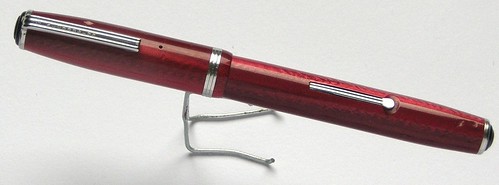
(the one from Mom)

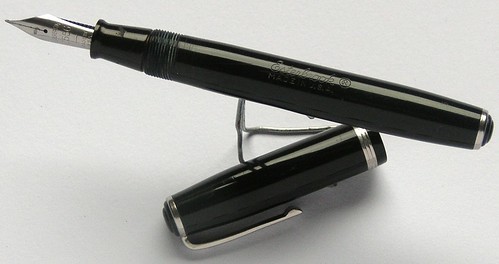

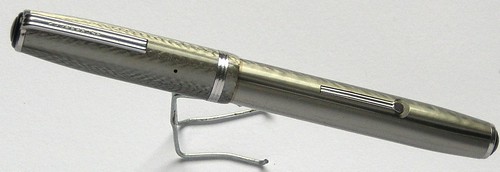


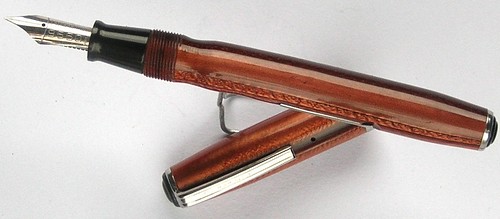
(See that this pen has been heated and stretched, presumably by someone trying to repair it clumsily. That’s why I’m not fixing any of the pens at hand without a good, gentle heater.)

You can see that although the basic design in the same for each, they vary in small particulars. The fill lever sometimes has a rounded end, sometimes a spade-shaped end. Sometime the clip has ‘Esterbrook’ imprinted on it, sometimes not. The barrel imprint may vary. The coloration of the plastics vary. If I were a serious Esterbrook collector, I’d try to track down as many of these variations as I could, but I’m not that hard-core.
Before the J, Esterbrook made the Dollar Pen — same colours, but with a different clip design and the jewel on the cap is continuous with the clip, and engraved with ‘Esterbrook’:
Between the Dollar Pen and the double-jeweled J, Esterbrook tried out several designs; this is a single-jeweled Transitional J, with the distinctive three-fin jewel on top (no jewel at the bottom):
After the J, Esterbrook introduced two variations on the theme: the LJ, which was about as long as the J but more slender, and the SJ, which was both more slender and shorter (nothing to do with the Jesuits). I have a couple of LJs and several SJs:

(LJ)

(LJ)
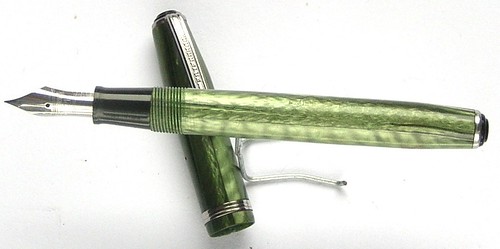
(SJ)

(SJ — and it looks as though sometime someone swapped the cap from a darker pen onto this)

(SJ)

(SJ)

(SJ)

(There are a lot of black SJs out there with custom imprints — many Bell telephone Esties, and this one’s from the Fort Wayne School System)

And there was a vogue for making special pens for women — this was the Esterbrook contribution to that species, the CH ‘Purse Pen’ in pastel colours, even shorter than the SJ:

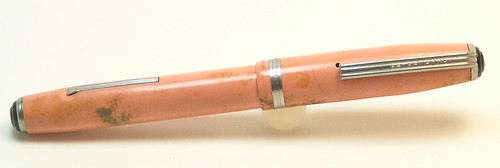
(This pink Purse Pen was horribly abused by a previous owner; I’ve cleaned it up considerably, but not completely, alas, since I took this photo a few years ago)
And finally, the royalty of my Esterbrook assembly, the LJ ‘icicle’ pens, so called for their characteristic vertical stripes:
So that’s the Esterbrook wing of my pen museum, the oldest specific collection among my pens (I’ve had other fountain pen types from longer ago, but this is the oldest set I deliberately gathered).
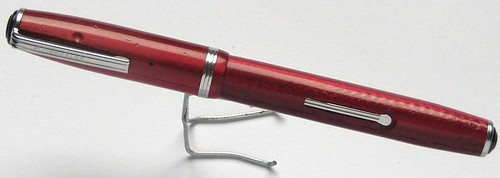
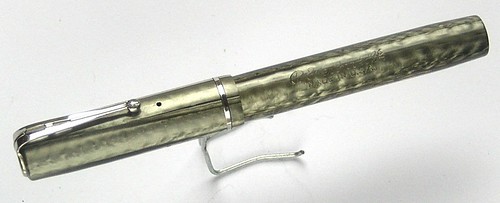


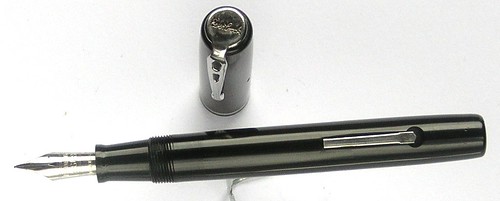

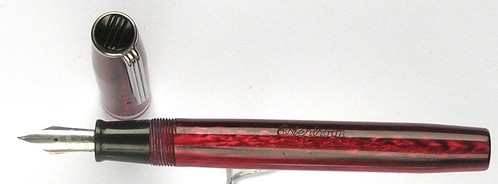
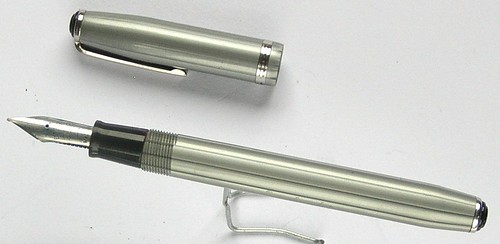


Gorgeous photos and terrific post!
I still have two of my Pens from Grammar school. I attended a new school in Azusa, CA in about 1952 (St. Frances Of Rome) and the nuns only allowed us to use Esterbrook pens.
I filled one of them last week and it still writes as well as it did when I got it. My favorite one (a black 2 jewel) must need a new sac as it no longer works. The other is a white purse pen. Both are stamped Esterbrook and are made in the USA.
Keep an eye on that purse pen, Michael; they’re less common and more prized. They (especially the white ones) sometimes sold in pairs with a similar pen body that served as a thermometer caddy. The black J should be easy to get repaired (even I can refit Esties).
The one I covet is the fountain pen model whose cap unscrews to reveal that it’s an aspergillum. I know Parker made one, and I’ve heard that Waterman did; I don’t know about Esterbrook, but that would be a great catch.